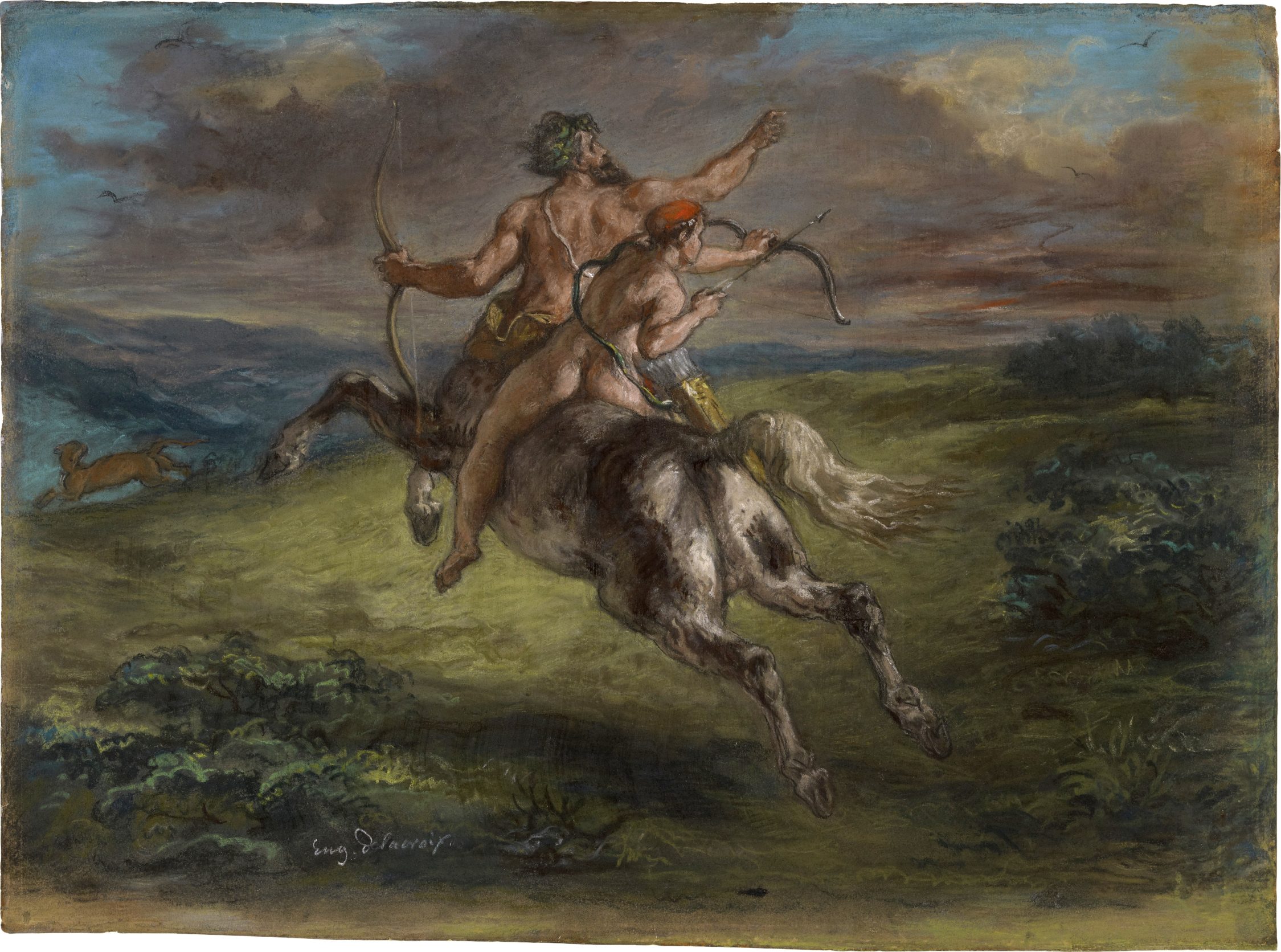The Constitution invites us—and politics compels us—to consider redrawing state and local borders.
Frogs Can’t Jump Backward

Righting the trajectory of the online right
The last decade has seen the rise to political prominence of the so-called “online right.” People use different names for the various overlapping elements of this growing constituency. There’s “Frog Twitter,” the “dissident right,” the “anon right,” the “manosphere,” and more. But however one refers to it, the movement has unique ideas and aesthetic proclivities that distinguish it from other right-wing factions. It boasts personalities with many thousands of online followers (Bronze Age Pervert, Raw Egg Nationalist, L0m3z, etc.). Increasingly, they have their own publications, (IM-1776, Man’s World,or The Asylum). Despite their taste for absurdist comedy, their powerful presence demands that we take their positions seriously. There is a flowering intellectual vitality among the Frogs today, which offers the potential to resist institutional leftism and perhaps re-found a social order more conducive to traditionalist and conservative cultural commitments.
Collectively, the Frogs want to catalyze some sociopolitical transformation, but is there a shared vision of the order they want to bring into being? What sort of transformation do they seek? A frenly critic must notice their written output betrays a good deal of confusion on this question. Some of their thinkers demand that we must “RETVRN” to the past and revitalize of an older way of life. Others insist upon a break with the past and present, calling for the construction of a new order and a different future. It is not only in comparing the ideas of different writers that we find this confusion: many thinkers contradict themselves on these questions.
Two Models of Transformation
Since the beginning of western society, there have been two opposing itineraries for how to achieve a transformation of identity.
The first, called metanoia, is where a person renounces his previous identity and proclaims himself to be a wholly new person. Metanoia is forward-looking. It makes a decisive break with the continuity of the past. It is future-oriented. It is a kind of forgetting—a departure from old things. As such, a metanoic transformation constitutes what the Greeks called a krisis (or a separation) and what we call a crisis (an emergent disruption of normalcy). The key characteristic of the new self that emerges at the conclusion of this crisis is difference. Metanoia valorizes “otherness.” Saul of Tarsus, who became Paul after he experienced a Christophany on the Road to Damascus, is the western metanoic archetype.
The second historical technique of personal transformation is called epistrophe. It inverts the concept of metanoia. The epistrophic convert proclaims that his previous self was inauthentic, or evil, or misconceived. But instead of characterizing the transformed identity as a new self, the convert proclaims that it is rather a return to an older, more primordial, authentic self that was always already there, but concealed by an inauthentic mask. Thus, epistrophe reestablishes a continuity with the past. It is a remembering—a return to old things. The movement of epistrophe is a backwards one. It embraces sameness, not difference. The Prodigal Son is an embodiment of the epistrophic type: having abandoned a mundane country life working for his father, he prematurely takes his inheritance and goes to the city to live as a libertine. But when the money runs out, he longs to go back to the stability of the old. Upon returning to his ontological homeland, his father restores his status as son—an identity he can now value and inhabit more faithfully because he has chosen it for himself.
For thousands of years, these were the two options for laying claim to a new identity. For thousands of years, they were mutually exclusive: one couldn’t simultaneously make a total break with the past and return to it. When it comes to personal transformation in our era, secular modernity is distinguished by a troubled attempt to reconcile metanoia and epistrophe. As Leftist reactionaries attack any claim to inviolable essence and actively seek to destroy the western cultural inheritance, they claim that transformation can be both a return and a departure, both a rejection of the old self and an affirmation of it.
This hybridized modern process of reinvention produces new identities like those of Caitlyn Jenner and Rachel Dolezal. In narrating his transformation, Caitlyn made a radical break with Bruce: surgical interventions created a new body, he started wearing dresses and cosmetics, and he took a new name. These features all indicate a metanoic conversion. But as Jenner emphasized the authenticity of the new identity, epistrophic themes were also on full display: Jenner insisted that Caitlyn was always inside Bruce, and that Bruce was a manque self. Only by publicly laying claim to the most essential self—the primordial, internal, feminine self—can Caitlyn become who he really is.
Rachel Dolezal was the biological daughter of what was apparently one of the whitest families in Idaho. After her parents adopted four black children, Rachel became fascinated with black identity. She attended a historically black college, and during that time she began presenting herself as a black woman. She eventually rose to the highest position in the Spokane NAACP (where everyone thought she was black). But after faking a number of “hate crimes” against herself, some journalists exposed her as a white woman.
At first, Dolezal denied it. But in the heat of the ensuing media frenzy, she tried to establish her authenticity by stating that she had always felt like a black woman. She explained that as a young girl she had fantasies that she was an Egyptian princess and that her white parents had abducted her. These epistrophic justifications suggest that presenting herself as black was just a means to be inhabit to her oldest, most essential identity. After all, Dolezal insisted, we’re all from Africa originally. A spiritual return to one’s “origin” is the epistrophic move par excellence. But all the features of metanoia were also present: her physical transformation happened very abruptly (black hairstyles, darkened skin, afrocentric dress). She took a new name. She created a new backstory.
In each case—Jenner and Dolezal—we are presented with a new identity that lays claim to a greater authenticity. And yet these are false identities—prima facie. How do we know? How do we know that Jenner isn’t really a woman? How do we know that Dolezal isn’t really black? Because we know you can’t be a man and a woman. You can’t be wholly white one day, and fully black the next. The fact that their conversion narratives try to reconcile the irreconcilable metanoic and epistrophic modes of transformation ultimately serves as one more indicator of the inauthenticity of these new/old selves. Because these two modes are mutually exclusive, any conversion process that tries to mix them will inevitably produce a confused identity, and thus, a spoiled one. There is a lesson here: one that will be critical for frogs and frog-adjacent people to learn—if they are to succeed in achieving any viable transformation of our culture.
Break or Return?
Are metanoia and epistrophe still applicable if what we’re transforming isn’t a person, but a spirit or sensibility? On the whole, the new right aims not at a transformation of the self, but of the zeitgeist. The spirit of the age must be transformed precisely because it does not allow us to live authentically. Our fight, properly understood, is a resistance to being personally changed by forces and figures that want to dictate the terms of our metamorphosis: we do not want to become the type of people who would feel at home in a pod life. The zeitgeist wants to shape us into something that denigrates our human essence. We seek to change our era’s identity so that we can retain our own. Unwilling to be transformed by the zeitgeist, we fight to transform it.
Metanoia and epistrophe are two road maps for implementing the cultural changes we seek. But there is confusion across the spectrum of the right about whether to follow the metanoic map or the epistrophic one. This tendency is especially pronounced among the Frogs. Their rhetoric intermingles demands that we RETVRN with calls for the new. If we try to have it both ways, we will fail. The reason that we will fail is because this mixing of the metanoic and the epistrophic paradigms is a hallmark of the soulless, secular modernity to which we seek an alternative. If we try to follow both paths, we will succeed only in producing a cultural identity that contains all the contradictions and oddities of transformations like those of Jenner and Dolezal, but taken to the scale of society writ large. If that happens, the world that we’re bringing into being will be stillborn—a perverse reiteration of the world that we were attempting to displace.
Some demonstration of the confusion that I have described is in order.
The back cover of Bronze Age Mindset announces the “Return of the spirit of the Bronze Age.” This reflects BAP’s generally epistrophic orientation to spiritual transformation. He says that the “Bronze Age has life and force […] I see this spirit returning in our age.” In his discussions of reincarnation, he seems to suggest that all things “will be reborn in just the same way” as they existed in the past. These passages echo Nietzsche’s critique of modernity and his epistrophic concept of the Eternal Return. And yet, BAP sees modernity itself as the product of an earlier epistrophic transformation: “The modern is ‘nothing new’: it is the return of a very ancient subjection and brokenness under new branding.” This results in a kind of contradiction: the modern malaise is the product of an epistrophic return of the old…and the solution to this malaise is an epistrophic return to the old.
Despite his dominant epistrophic inclination, in other spots we see BAP’s ambivalence about which path to take, where he speaks in a metanoic register: “I can imagine few fates worse than if we decided to ‘live closer to our means,’ to retrench and stop technological progress and innovation, to scale back to ‘small, integral communities,’ to bring back ‘traditional forms’ in our circumstance.” He is correct that such a return couldn’t be achieved even if we wanted it, and BAP warns that attempting an epistrophic transformation of this sort might actually intensify the dysfunction of modernity: “Any such attempt [to return to these things] in the modern world […] will lead not to the reestablishment of the glories of past ages, but to the freezing of modern corruption, to its stabilization and permanence.” Although this diagnosis is invaluable, it leaves us without a map for transformation. While the theme of epistrophic return saturates his writing, BAP indicates that we can’t go back.
Other prominent voices of the online Right exhibit these epistrophic themes. In the pages of The Asylum, Stone Age Herbalist proclaims his commitment to the epistrophic itinerary: “I wish only to see the truth prevail and for a glorious recovery of the dynamic, bellicose, and vital energies which once dominated the plains, the coasts, the woodlands, and the valleys.” In the same publication, Charles Haywood looks back enthusiastically to the Caesars, and eagerly awaits the epistrophic return of the king—a yearning shared by Curtis Yarvin. But the yearnings for a future-oriented metanoia are never far.
Consider also L0m3z’s Passage Prize, an artistic competition that seeks to revive the tradition of poetry, visual art, and fiction among the online Right. I among many others deeply appreciate the attempt to reclaim aesthetics from a Left devoted to effeminized, flaccid propaganda. L0m3z understands that artistic prowess is virtually a precondition of any cultural transformation. And yet, the theme of his contest is “Exit from the Longhouse,” which alludes to a coming departure from the matriarchal, communal, static, organization of life in the West. But the metanoic “passage” or transformation is advanced by epistrophic metaphor. The modern world, while bearing some characteristics of the longhouse, is nevertheless the product of a metanoic movement away from the native cultures of the longhouse. Thus, “exiting the longhouse” in 2022 announces a metanoic departure from a culture that we departed (and nearly annihilated) over a century ago. In this sense, we see an epistrophic anticipation of a transformation that already occurred—a contradiction in terms.
The same trends are observable in the visual art being produced on the right. In the first issue of The Asylum, Barron Trump demonstrates his considerable skill in painting. His subject? A Roman soldier. This partakes in the typical nostalgia—the longing for an epistrophic RETVRN. An artist named Elephant Guy contributes drawings that recall scenes reminiscent of daily life in ancient or Medieval tribal societies. More epistrophe.
Then, there is the beautiful sculpture of Fen de Villiers. I cannot deny his craftmanship. And yet, his work thus far loudly echoes the aesthetic developed by Futurists in the early twentieth century, particularly Italian painters and sculptors Carlo Carra and Umberto Boccioni. More than these though, de Villiers’ style recalls that of Wyndham Lewis. Lewis was the British progenitor of Vorticism, another school of the twentieth century avant garde. The Futurists and the Vorticists produced art as a means to foment metanoic cultural change, and they routinely announced the political aims of their art through the literary genre of the “manifesto.” De Villiers has also produced a manifesto, further hinting at his epistrophic trajectory for cultural renewal.
Obviously, there is no escaping the influence of artists who came before, but Futurism and Vorticism are odd traditions to mine for a project of epistrophic transformation. This is because both were decidedly metanoic movements that insisted upon a forceful rejection of the past to birth something new. F.T. Marinetti’s 1909 manifesto, the first of many among the Italian Futurists, brutally disparaged the epistrophic nostalgia that they saw in Italian art of prior decades: “It is from Italy that we launch through the world this violently upsetting incendiary manifesto of ours. With it, today, we establish Futurism, because we want to free this land from its smelly gangrene of professors, archaeologists, ciceroni and antiquarians. For too long Italy has been a dealer in second-hand clothes. We mean to free her from the numberless museums that cover her like so many graveyards. Museums: cemeteries!”
Another profoundly metanoic passage comes from BLAST, the Vorticist manifesto edited by Wyndham Lewis and Ezra Pound in 1914 and 1915: “But our industries, and the Will that determined face to face with its needs, the direction of the modern world, has reared up steel trees where the green ones were lacking; has exploded in useful growths, and found wilder intricacies than those of nature.” In de Villiers’ art, then, we find an epistrophic remembrance of an artistic tradition that was based on metanoic transformation via a rejection of nostalgia and the past—that is, a rejection of epistrophic remembrance.
Raw Egg Nationalist offers an honest critique of the right-wing fetishization of the past, pointing at the epistrophic nature of RETVRN and TradWife memes, and rightly voicing suspicion that we are fundamentally unable to recapture the past because it has passed. But his essay “Tacitus and the Return to Tradition” is also non-committal when it comes to the question of whether to choose the epistrophic model of transformation or the metanoic one: “If conservatives really do want to create a future for the past, they must put forward an alternative history” [emphasis added]. An “alternative history” suggests a metanoic trajectory; a “future for the past” suggests an epistrophic one. Despite his criticism of the RETVRN model, REN then proposes the work of Tacitus as offering a “pragmatic” approach to our situation. Tacitus lived 2,000 years ago. Not that there’s anything wrong with that—but it’s a decidedly epistrophic move. In the prior issue of The Asylum, The Fat Nutritionist lofted a lovely critique of the “gentleman conservative” who is transfixed by an impotent, epistrophic nostalgia for a past that cannot be reclaimed.
Toward a Metanoic Future: The Past is Gone
In short, the discourse of the nascent renaissance occurring on the Right is largely incoherent: are we fighting to reclaim the past and ensure its endurance in the future, or are we rejecting the present (and the past that undeniably produced it) to forge a new path and a new culture? In contrast to the prominent thinkers of the online Right, my contention is that it can’t be both. We can’t achieve an epistrophic metanoia. That concept is a contradiction in terms, and it is a decidedly modern invention. Transformations that have simultaneously sought a rupture with the past and tried to establish a historical continuity have only been successful in producing ideas and identities that reaffirm the contradictions of modern secular liberalism—the source of the forces that we oppose. Think Jenner. Think Dolezal.
And the choice between metanoia and epistrophe isn’t simply personal preference. If we are going to win the war into which we have been thrust, we cannot leave this matter to the judgment of the individual. The odds are stacked against us already. If we are not united in our understanding of what we are trying to accomplish, we only undermine our meager prospects for victory. The choice before us is perhaps the most urgent one we face. Put in everyday terms, it is a question of whether we are playing offense (metanoia) or defense (epistrophe). Are we destroying something to create something new, or are we recreating something that existed in the past?
The epistrophic path exposes some rhetorical vulnerabilities that are effectively exploited by leftists. The traditionalists’ yearning for the old, for the past, validates our opponents’ claims that “conservatives” are consumed by a romantic nostalgia, that they want to “go back” or “turn back the clock.” Leftists also successfully paint this nostalgia as naïve, suggesting that “the glories of past ages” are merely a fantasy projected onto our history by those who feel spiritually isolated in the present. There is some truth to this line of attack. The Bronze Age sucked in many ways. If the argument is that the suckiness of the past was less sucky than the suckiness of the present, well…the truth of this claim can’t be assessed. This means that catalyzing a “return” is dangerous business.
As for me, then, I humbly suggest we pursue the metanoic path. Change is an inexorable consequence of the passage of time. In some sense, the failure of modern conservatism is the result of a fool’s errand: you can stand athwart history yelling “Stop!”—as loud as you can and for as long as you want. But history doesn’t listen. It doesn’t end. The “progressives” who have chosen a metanoic itinerary understand this, associating themselves with the concept of novelty to curry favor in an era which valorizes innovation and change. “Progressives” seek a break with the past. They are always swimming with the current. And they win. If the central task of epistrophe is recreating something that we once had but have now lost, then we’re doomed to fail. The challenge that we face is an epochal one, and “recreation” simply isn’t a viable response to the monumental task at hand. Pepe, meet Paul.
The American Mind presents a range of perspectives. Views are writers’ own and do not necessarily represent those of The Claremont Institute.
The American Mind is a publication of the Claremont Institute, a non-profit 501(c)(3) organization, dedicated to restoring the principles of the American Founding to their rightful, preeminent authority in our national life. Interested in supporting our work? Gifts to the Claremont Institute are tax-deductible.
Any critique of the online right needs a full understanding of its ethos.
There’s a generation gap on the Right, and it’s hurting us.



